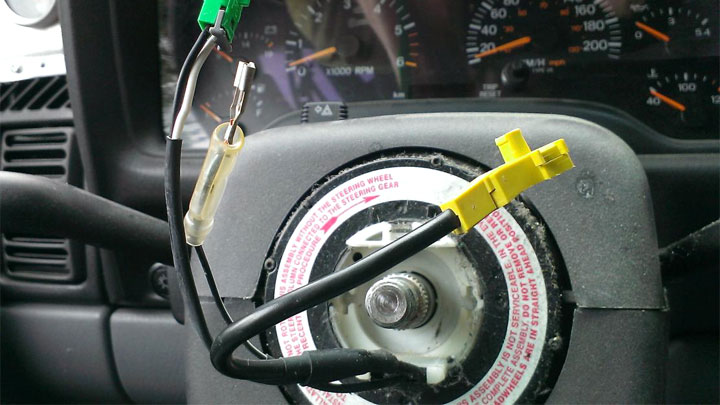Last Updated on June 21, 2022
Any vehicle with numerous miles beneath its belt is subject to a certain degree of wear and tear. With time, this wear and tear can lead to the failure of many different components, each of which is designed to play a pivotal role in vehicle operation. While such failure can ultimately prove frustrating, it comes as a natural part of vehicle ownership.
While many car owners anticipate the need to replace brake and suspension components as the result of such wear and tear, the effective service life associated with many other parts often goes overlooked. In certain cases, motorists seldom even consider the existence of such components, until they become the source of significant issues.
One extremely important, yet often overlooked component is the clock spring. This essential component plays a pivotal role in facilitating the function of electronic devices that could not otherwise exist as we know them today.
Likewise, a vehicle’s clock spring can also pose a number of troubling issues, when in the midst of failure. Read on to learn more about your vehicle’s clock spring, as well as the numerous symptoms associated with its failure.
What Is a Clock Spring?

A clock spring is an assembly that features a flat-ribbon spiral cable that can be extended and retracted as needed, maintaining circuit viability.
Devices of this nature are employed in situations where wiring for a particular circuit is required to move on a continual basis. In such instances, wiring of any other configuration would degrade rapidly.
What Does It Do?
A clock spring facilitates the function of various electronic automotive accessories, which are manipulated via a non-stationary controller. Simply put, a clock spring extends and retracts as needed to meet the needs of a non-stationary circuit.
This is most presently used in the design of the modern automotive steering wheel.
Where Is It Located?
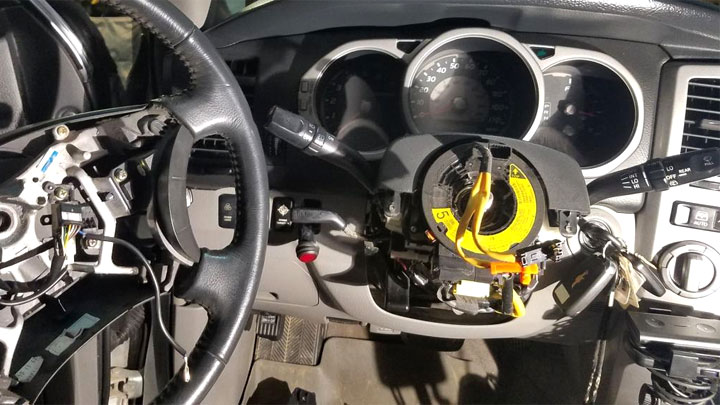
A vehicle’s clock spring is located between its steering column and steering wheel. This allows a number of steering wheel-controlled functions to operate as intended, despite the steering wheel’s constant movement.
Some of the most notable of these functions include the horn, push-button radio controls, and cruise control. A vehicle’s driver-side airbag is also supplied power via the clock spring.
Symptoms of a Bad Clock Spring
A faulty clock spring is often accompanied by several additional symptoms, some of which tend to be more troubling than others.
The following are several of the most common symptoms associated with a bad clock spring.
#1 – Inoperable Steering Wheel Buttons
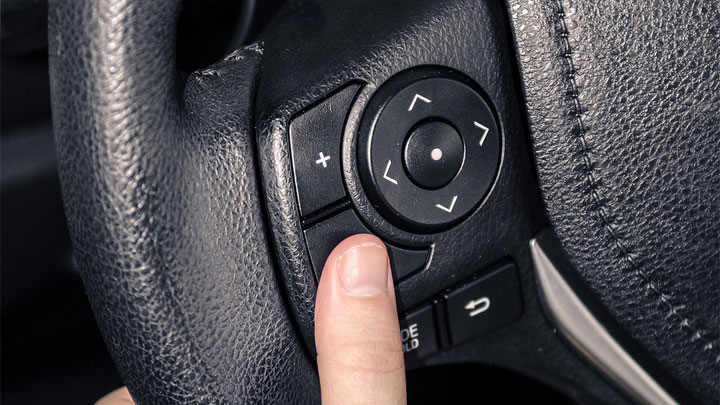
When a clock spring fails, one will often notice that their vehicle’s steering wheel-mounted controls no longer work. This often involves some cruise/radio control functions.
This lack of operation stems from a separation of the actual wires that feed power and ground to each of these functions. Unfortunately, operability is only restored through clock spring replacement.
#2 – Miscellaneous Warning Lights
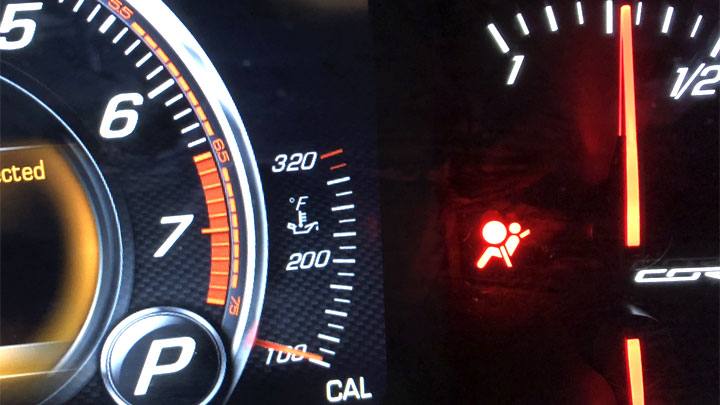
Another common symptom of a damaged or faulty clock spring is the sudden illumination of one or more warning lights upon a vehicle’s dash.
The most commonly observed of these lights include the “airbag” light, which indicates a fault within the airbag circuit itself. A vehicle’s traction control or electronic throttle warning lights might also be activated.
#3 – Lack of Horn Function

A motorist is also likely to find that their vehicle’s horn is inoperable, in the event of clock spring damage. This stems from the fact that the horn’s power supply (clock spring) has been severed. This can pose quite a safety concern and warrants immediate diagnosis and repair.
The horn itself will remain inoperable until the faulty clock spring is replaced or repaired.
#4 – Unusual Steering Wheel Noise

In some cases, a damaged clock spring might also be accompanied by a “rubbing” or “grinding” noise. This noise stems from unintended friction within a vehicle’s steering column itself, caused by the misalignment of one or more clock spring-related components.
As the steering wheel is turned, these components drag across one another, in ways that would not otherwise be possible.
#5 – Blown Fuses
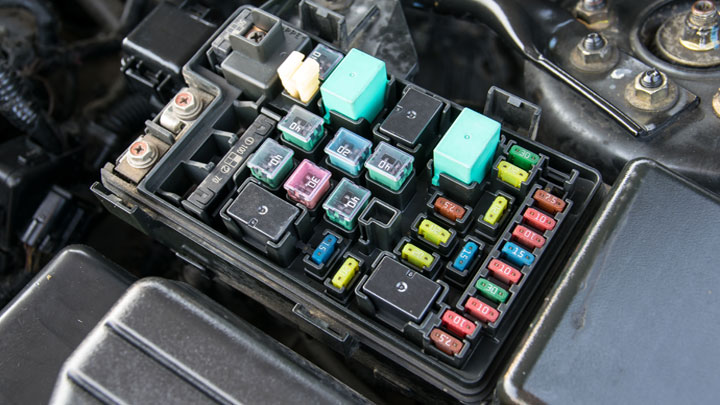
A damaged clock spring might also result in the rapid failure of one or more fuses related to various steering wheel-controlled functions. This occurs when the wires of live circuits are allowed to move about, arcing off of grounded surfaces.
As a result, the fuses that correspond to each of these circuits blow, as a matter of circuit protection.
What Causes a Clock Spring Failure?
The failure of a vehicle’s clock spring is generally attributed to normal wear and tear. This stems from the fact that a clock spring’s ribbon of wires moves with every revolution of a vehicle’s steering wheel.
As such, a certain degree of wear and tear is imminent. The wear only progresses until eventual failure occurs.
Clock spring failure can also occur as the result of steering wheel over-rotation, at any time that a vehicle’s steering linkage is disconnected.
Simply put, the rotation of a vehicle’s steering wheel is typically limited by the turning radius of its wheels. However, when a vehicle’s steering linkage is disconnected, this limitation is removed, allowing the steering wheel to turn indefinitely.
If steering a wheel is turned more revolutions than allowed by its clock spring, the clock spring itself will be damaged as a result. This will necessitate clock spring replacement before full electrical functionality can be restored.
Can You Drive With a Broken Clock Spring?
Driving a vehicle with a broken clock spring is not advisable. This stems from the fact that a vehicle’s clock spring provides power/ground to a couple of critical vehicle safety functions. These include a vehicle’s horn and airbag.
As a result, driving a vehicle with a damaged clock spring might actually constitute a safety risk of its own.
Clock Spring Replacement Cost
Best places to order parts? See: 19 Best Online Auto Parts Stores
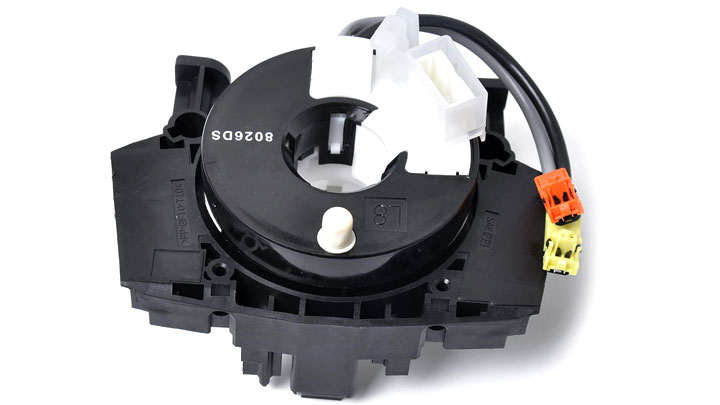
On average, clock spring replacement tends to fall within a range of $200-$750. While this is quite a broad price range, the labor involved with such a repair varies significantly from one model of vehicle to the next.
Replacing a clock spring can be somewhat involved at times, thereby necessitating higher labor costs. The actual price of the clock spring itself also varies, depending upon vehicle make and model.
Related: Average Airbag Replacement Cost
Can You Replace a Clock Spring On Your Own?
You can certainly replace your own clock spring, thereby eliminating costly labor expenses. However, this is also a repair that requires a certain degree of mechanical aptitude to complete.
Clock spring replacement requires the removal of a vehicle’s steering wheel and airbag assembly. This can be challenging, and often requires the use of specialty tools, such as a steering wheel puller.
In any event, you should only tackle such repairs if you are comfortable doing so. If this is not true in your particular case, schedule an appointment with a trusted automotive service center at the first available opportunity.
Can You Repair a Clock Spring?
In some cases, it is possible to repair a vehicle’s damaged clock spring. However, replacement as a whole is generally accepted as the gold standard of repair. This is due to the fact that a clock spring is somewhat delicate, and often difficult to repair properly.
It is also worth considering the fact that a clock spring facilitates the function of safety-related components, such as the horn and airbag.

